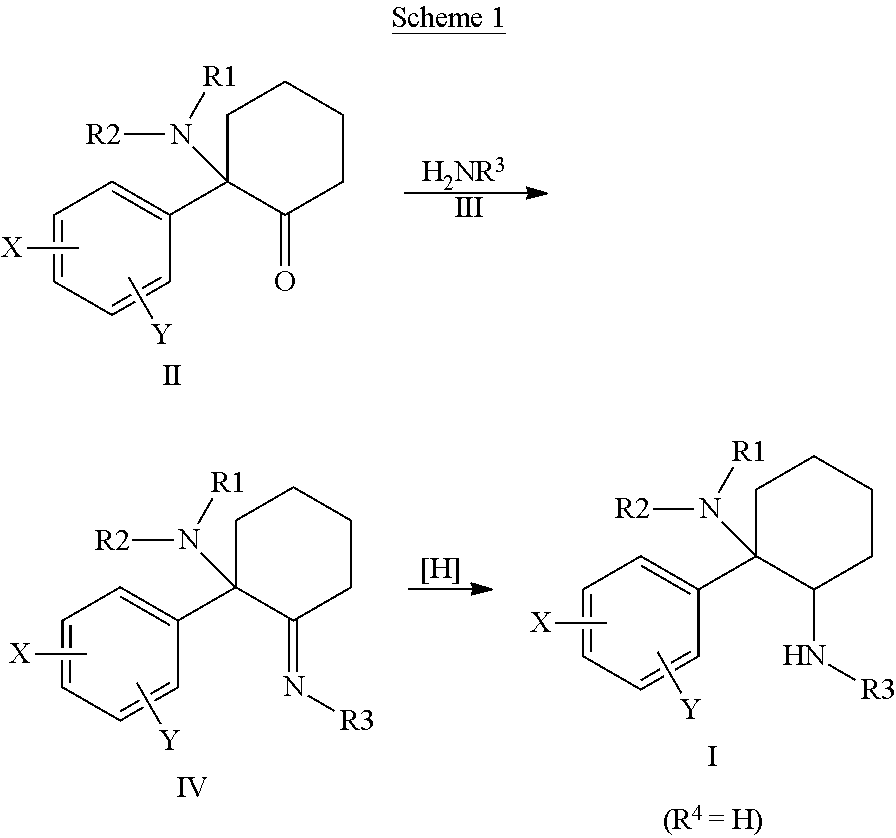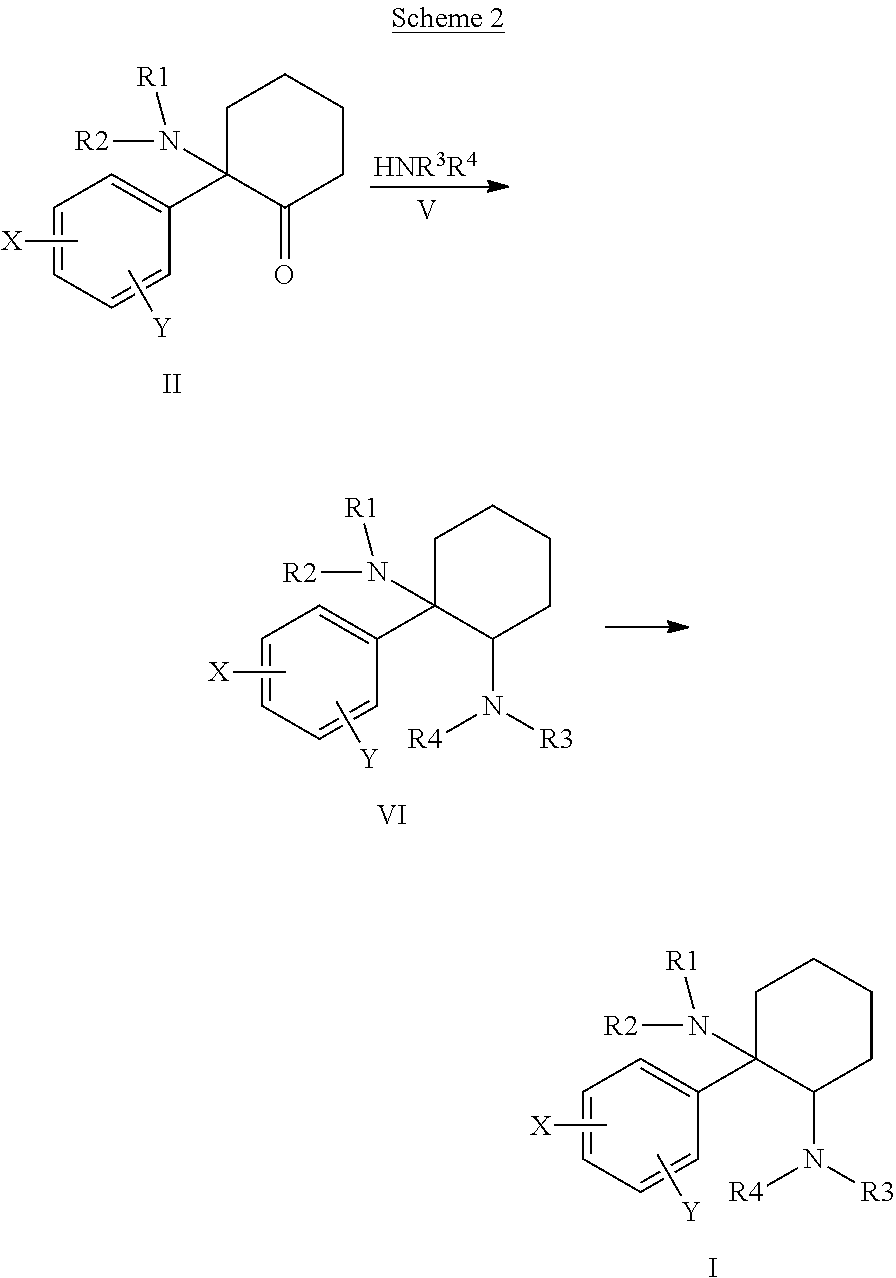Cycloalkyl-Diamines
- Summary
- Abstract
- Description
- Claims
- Application Information
AI Technical Summary
Benefits of technology
Problems solved by technology
Method used
Image
Examples
example 1
General Procedure A
Trans-1-(2-chlorophenyl)-N2-(2-(dimethylamino)ethyl)-N1-methylcyclohexane-1,2-diamine (1a) and Cis-1-(2-chlorophenyl)-N2-(2-(dimethylamino)ethyl)-N1-methylcyclohexane-1,2-diamine (1b)
[0211]A mixture of 2-(2-chlorophenyl)-2-(methylamino)cyclohexanone hydrochloride (ketamine HCl) (423 mg, 1.54 mmol) and N1,N1-dimethylethane-1,2-diamine (1.6 mL, 19.2 mmol) was heated at 110° C. for 20 h. The mixture was cooled to room temperature and sodium cyanoborohydride (490 mg, 7.8 mmol) was added. The mixture was then heated at 110° C. overnight. The cooled reaction mixture was quenched with saturated NaHCO3, extracted with CH2Cl2 (75 mL), dried (Na2SO4) and concentrated to dryness to give 500 mg of crude product (M / Z 310 [M++H]). This material was further purified by column chromatography, as described in Method A above.
[0212]a.) The product fractions, (RT=0.50) were combined, the solvents were removed and the trans-isomer was isolated as a trifluoroacetate salt, 0.149 g.
[0213...
example 2
Trans-1-(2-chlorophenyl)-N2-cyclopropylmethyl-N1-methylcyclohexane-1,2-diamine (2a), and Cis-1-(2-chlorophenyl)-N2-cyclopropylmethyl-N1-methylcyclohexane-1,2-diamine (2b)
[0218]The title compounds of Example 2 were prepared according to general procedure A using cyclopropylmethanamine and ketamine.
[0219]a.) LC (RT=0.55) / Mass spectrum (m / z) calcd. for C17H25ClN2: 292.8; obsd.: 293 (M+1, 100%), 295 (M+1, 37Cl, 30%), 262 (28%).
[0220]1H-nmr (DMSO-d6, 400 MHz, T=30° C.) δ 0.1 (m, 2H), 0.2 (m, 2H), 0.5 (m, 2H), 0.85 (m, 1H), 1.50 (m, 2H), 1.65 (d, 1H), 1.85-2.10 (m, 2H), 2.05 (s, 3H), 2.15 (m, 2H), 2.30-2.55 (m, 2H), 2.70 (dd, 1H), 4.45 (s, 1H), 7.40-7.65 (m, 4H).
[0221]b.) LC (RT=0.72) / MS: calcd. for C17H25ClN2: 292.8; obsd.: 293 (M+1). 1H-nmr (DMSO-d6, 400 MHz, T=30° C.) δ 0.30 (m, 2H), 0.55 (dd, 2H), 1.0 (m, 1H), 1.2 (m, 1H), 1.40-1.85 (m, 5H), 2.05 (m+s, 4H), 2.80 (m, 3H), 4.20 (m, 1H), 6.5 (bs, 2H), 7.35-7.50 (m, 2H), 7.52 (dd, 1H), 7.64 (d, 1H).
example 3
Trans-1-(2-chlorophenyl)-N2-cyclopentyl-N1-methylcyclohexane-1,2-diamine (3a), and Cis-1-(2-chlorophenyl)-N2-cyclopentyl-N1-methylcyclohexane-1,2-diamine (3b)
[0222]The title compounds of Example 3 were prepared according to general procedure A using cyclopentylamine and ketamine.
[0223]a.) LC (RT=0.58) / MS: calcd. for C18H27ClN2: 306.9; obsd.: 306.19 (m+1).
[0224]b.) LC (RT=0.96) / MS: calcd. for C18H27ClN2: 306.9; obsd.: 306.19 (m+1).
PUM
 Login to View More
Login to View More Abstract
Description
Claims
Application Information
 Login to View More
Login to View More - R&D
- Intellectual Property
- Life Sciences
- Materials
- Tech Scout
- Unparalleled Data Quality
- Higher Quality Content
- 60% Fewer Hallucinations
Browse by: Latest US Patents, China's latest patents, Technical Efficacy Thesaurus, Application Domain, Technology Topic, Popular Technical Reports.
© 2025 PatSnap. All rights reserved.Legal|Privacy policy|Modern Slavery Act Transparency Statement|Sitemap|About US| Contact US: help@patsnap.com



